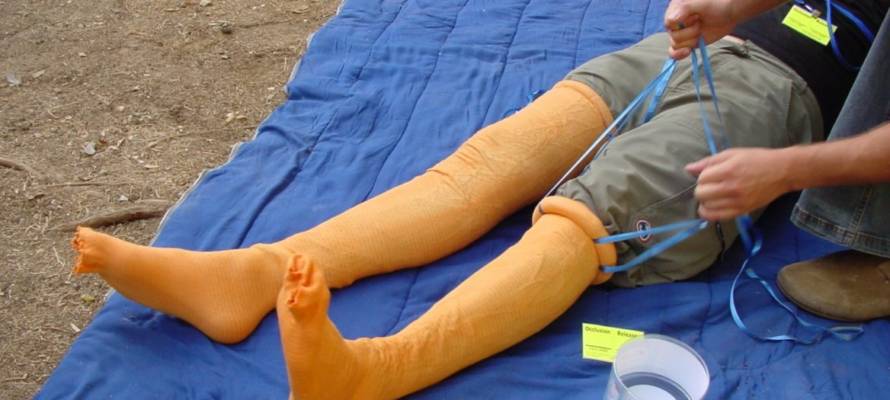Simple emergency solution from an Israeli physician-inventor redirects blood to core organs from limbs in case of hemorrhagic shock or cardiac arrest.
By Abigail Klein Leichman, ISRAEL21c
The 1940s inflatable anti-gravity suit kept fighter pilots from losing consciousness by preventing blood from pooling in their legs. That invention inspired medical anti-shock trousers used in the 1950s to 1970s to stabilize hemorrhagic shock patients by shifting blood from their legs to their core organs.
As a young medical officer in the Israel Defense Forces in the late 1970s, Dr. Noam Gavriely found several technical and logistical problems with anti-shock trousers: it took two people and a good few minutes to position them, and when they were removed the patient’s blood pressure took a dangerous dive.
Gavriely went on to become a serial medical-device inventor and emergency-care physician. His latest invention, HemaShock, accomplishes the same goal as anti-shock trousers but quickly and easily, without air pressure.
Introduced to the market in November last year at a price of $175 per set, the made-in-Israel device is an elastic silicone ring wrapped in stockinet fabric. It is rolled up the leg by one medic in about 30 seconds, without the need to remove the patient’s pants, and rolled off gradually to prevent a sudden drop in blood pressure.
For a patient in shock from loss of blood, HemaShock acts as an auto-transfusion device, redirecting blood from one or both legs – about a half liter per leg — to essential organs.
The procedure is much faster than a transfusion and doesn’t require donated blood. The device can also act as a tourniquet for a leg bleed, though it isn’t meant to replace traditional tourniquets.
Heart Attack Treatment
Aside from shock, says Gavriely, HemaShock can save patients in non-trauma cardiac arrest.
A large British study recently published in The New England Journal of Medicine shows that fewer than 16 percent of people treated for cardiac arrest outside a hospital make it to the emergency room with a functioning heart. And the vast majority of that 16% ultimately do not survive.
The disappointing success rate despite emergency treatments such as CPR, electric defibrillation and adrenaline, says Gavriely, is mostly because the damaged heart doesn’t contain enough blood to be pumped out with the external chest compressions.
“HemaShock takes the blood from the legs and shifts it to the core. The heart gets filled up with the patient’s own blood and at the same time the legs are prevented from receiving any blood flow, so CPR compressions channel the blood to the brain, heart, kidneys and other essential organs, which is exactly what we want,” he explains.
HemaClear for Orthopedic Surgery
HemaShock actually is a repurposed product based on Gavriely’s successful HemaClear device to displace blood from limbs for bloodless orthopedic surgery.
“I developed the device in the early 2000s. Today we are selling HemaClear in 42 countries,” including the US, China, Australia and European nations. “HemaClear has been used in more than 1.2 million cases. It provides much better safety to the patient and easier work for the surgeon.”
Gavriely used the proceeds from HemaClear sales to bring the same product back to the field that inspired it in the first place: emergency medicine. The only difference between HemaClear and HemaShock, besides the packaging, is that HemaShock is not sterile.
Both products can stay in place for up to two hours without concern about permanent damage to the legs from lack of blood circulation.
Introduced at last November’s Medica international trade fair, HemaShock is already on its way to customers in Italy, the UK and South Korea, while the regulatory approval process is starting in Brazil and Argentina. In the United States, HemaShock for now is FDA-approved as an auto-transfusion tourniquet device pending further clinical trials to expand into the product’s specific indications.
Trials on a small number of patients at Eisenhower Medical Center in California show promising results in cases of hemorrhagic shock and of cardiac arrest, Gavriely reports. Larger studies are planned.
Serial Medical-device Inventor
HemaClear and HemaShock are marketed by US-based OHK Medical Devices, a fully owned subsidiary of Gavriely’s Oneg HaKarmel company in Tirat Carmel near Haifa.
He has commercialized other medical inventions over the years through the companies Cardio-Acoustics (cardiopulmonary analysis), KarmelSonix (asthma and cough monitoring) and ETView (visualization endotracheal tubes).
“My background was always on the boundary between clinical medicine and R&D,” Gavriely tells ISRAEL21c.“Already in medical school I started looking into the science of listening to lung sounds through stethoscopes because I wasn’t satisfied with what we were taught. That put me on a trajectory to a PhD in physiology studying mechanisms of lung sounds in parallel to working on my MD degree and becoming proficient in intensive-care medicine.”
Gavriely did a post-doc at Harvard School of Public Health in the 1980s and a fellowship in pulmonology at Brigham and Women’s Hospital in Boston. He practiced emergency medicine for 21 years in Illinois and was a professor of physiology at his alma mater, the medical school of the Technion-Israel Institute of Technology.
“In the mid-1990s I came to the conclusion that academic research is wonderful but the real impact is in industrial and commercial R&D to develop products that can directly help people,” he says.
